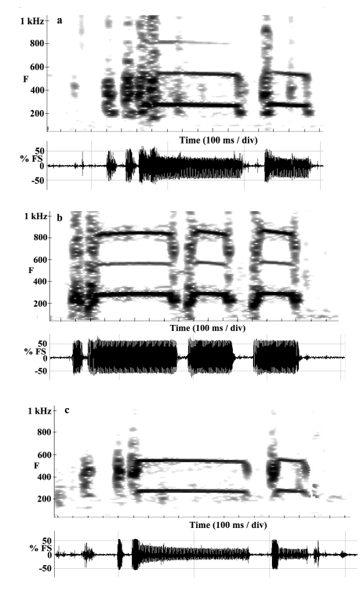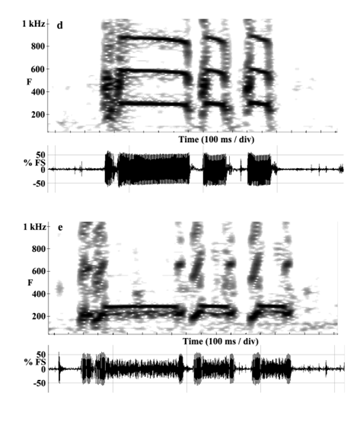Workshop Proceedings: Short Papers
Acoustic Competition in the Gulf Toadfish Opsanus beta:
Crepuscular Changes and Acoustic Tagging
Michael
L. Fine and Robert F. Thorson*
Department of Biology
Virginia Commonwealth University
Richmond, VA 23284-2012
* Present address: 133 Mockingbird Rd., Tavernier, FL 33070
We quantified crepuscular variation in the emission rate and call properties
of the boatwhistle advertisement call of Gulf toadfish Opsanus beta from
a field recording of a natural population of nesting males in the Florida
Keys. Their calls are more variable and complex than previously reported
(Fig. 1). A call typically starts with a grunt followed by one to five
tonal boop notes (typically two or three) and lasts for over a second.
The first boop is considerably longer than later ones, and intervals between
boops are relatively constant until the final interval, which approximately
doubles in duration. Positions of fish are fixed for long periods, and
calls are sufficiently variable that we could discern individual callers
in field recordings (Fig. 1). Calling rate increases after sunset when
males tend to produce shorter calls with fewer notes (Fig. 2). Analysis
by number of notes per call indicates some individuals decrease the number
of initial grunts and the duration of the first note, but most of the
decrease results from fewer notes. To our knowledge this sort of call
plasticity has not been demonstrated before in fishes. We suggest that
call shortening lowers the chances of overlapping calls of other males
and that the small amount of time actually spent producing sound (total
on time) is an adaptation to prevent fatigue in sonic muscles adapted
for speed but not endurance.
Anomalous boatwhistles contain a short duration grunt embedded in the
tonal portion of the boop or between an introductory grunt and the boop
(Fig. 3b, c). Embedded grunts have sound pressure levels and frequency
spectra that correspond with those of recognized neighbors, i.e. we are
able to identify individuals based on frequency spectrum of their grunts
(Fig. 4). We therefore suggest that one fish is grunting during another’s
call, a phenomenon here termed acoustic tagging. Snaps of nearby pistol
shrimp may also be tagged, and chains of tags involving more than two
fish occur (Fig. 5). The stimulus to tag is a relatively intense sound
with a rapid rise time, and tags are generally produced within 100 ms
of a trigger stimulus. Time between the trigger and the tag decreases
with increased trigger amplitude. Tagging is distinct from increased calling
in response to natural calls or stimulatory playbacks since calls rarely
overlap other calls or playbacks. Tagging is not generally reciprocal
between fish suggesting parallels to dominance displays.
 
|
| Fig. 1. Sonagrams and oscillograms from five individual Opsanus beta |
 |
| Fig. 2. Sonagrams from 4-, 3-, 2-, and 1-boop calls from an individual Opsanus beta. |
 |
| Fig. 3. Sounds of Opsanus beta illustrating acoustic tagging. (a) A typical boatwhistle with an initial grunt (G), a long tonal boop B1 and two shorter boops (B2 and B3). (b) Sonagram and (c) oscillogram of a boatwhistle tagged by another fish. The T marks the tag, which has lower frequency energy and greater amplitude than the boatwhistle. |
 |
| Fig. 4. Plot of peak amplitude in dB against the frequency of peak amplitude from grunt spectra for four toadfish recorded at weekly intervals. |
 |
| Fig. 5. Tags of shrimp snaps. (a) oscillogram of a pistol shrimp snap tagged by fish 1 with a latency of 41 ms shown in real time. (b) Same selection expanded. (c) Chain of tags initiated by a shrimp snap that is tagged by fish 3. Fish 3’s grunt is then tagged by fish 2, who in turn is tagged by fish 1. |
Return to Top | Workshop Proceedings: Short Papers